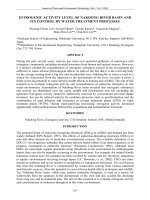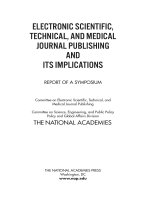symbolic space french enlightenment architecture and its legacy by richard a etlin
Bạn đang xem bản rút gọn của tài liệu. Xem và tải ngay bản đầy đủ của tài liệu tại đây (43.06 KB, 4 trang )
Detailed book review, subject could also be French Architecture
Richard A. Etlin, Symbolic Space: French Enlightenment Architecture and Its Legacy. Chicago:
The University of Chicago Press, 1994; xxv + 198 pp.; 113 ills.
Richard Etlin, in his study, Symbolic Space: French Enlightenment Architecture and Its Legacy,
offers his insight into the integral relationship architecture has within the activities of man.
Politics, science, social organization, and religion, all have spaces unique to their own functional
character. Beyond a functional character, however, there exists a deeper, more spiritual
connection man has with his surroundings. The emotional role of architecture is one focus of
Etlin's work. In his treatment of emotion and its relevance in architecture, Etlin relates modern
designs with those of the visionary French architects during the late eighteenth century.
In understanding the role of emotion, Etlin first establishes his notion of space. Mankind has the
unique ability to control, design, and shape his environment to his needs. "Architecture is
concerned primarily with the creation of domains for human activity," Etlin writes. Apart from
activity alone, architecture creates "spatial realms with qualities that affect the viewer and the
user." Architecture can establish a meaning and a feeling; it will affect man's mood. The mood is
created and controlled by an architect's use and design of space. Etlin elaborates more on this idea
of space, "All of these intellectual and subjective considerations about space, which reach beyond
the mere measurement of height, width, and depth, and beyond the mere description of geometric
features, are aspects of symbolic space." Symbolic space elevates architecture into something
more cerebral and more personal than just the basic elements. It imparts the same notion and
feeling of viewing a work of art, but allowing man more freedom; the freedom to use a work of art
for his own benefit. The functional aspect of space is very important: "We find that symbolic
space is invariably commingled with the various codes of order by which humans organize their
world." Symbolic space is broken down into three types, which form Etlin's "unifying thread" of
his book: primal space, organized space based on social codes, and the multi-layered space of
meaning within a particular place. Using this framework as a guide, Etlin concentrates on
demonstrating the symbolic similarities of modern architects such as Cret, Wright, and Le
Corbusier, with the theoretical works of visionaries such as Boullee and Ledoux.
Etlin begins his work with the phrase, "The Eighteenth century saw radical changes in the world of
architecture." Stemming from the ideas of the Enlightenment, architecture began to take on a new
type of dynamic. It was beginning to move more towards an active role in everyday life, centered
upon the ideal of embellissement, or embellishment. Architecture and the changes occurring in
this field during the eighteenth century "must be understood to include cultural aspirations and
functional amenities as well as aesthetic pleasures." Space was starting to take on meaning; it
was to create an impression.
Boullee is a prime example of space encompassing some type of meaning. His buildings were to
have an expressive and metaphorical character, but perhaps more importantly, he wanted them to
have a symbolic character. "Boullee provided each of his civic buildings with a temple-like space
consecrated to the idea of the institution housed there," Etlin writes. This idea could be expressed
through his use of domes, or peristyles, to indicate some type of importance to a building. The
observer is able to glance at a building, and immediately identify with the importance of the event
taking place there. Boullee's neoclassical legacy can be identified with more modern buildings in
Washington, D.C. Etlin uses the example of the National Archives Building (1933-1935) to
demonstrate a link to the architects of the past. The Archives Building houses such important
documents such as the Declaration of Independence and the Bill of Rights under a
"hemispherically domed rotunda". Etlin tries to invoke the neoclassical images of these
buildings, but takes this image one step further. One must also consider the documents housed in
this building:
It would be difficult to find a more appropriate match between the ideas expounded in these
documents, the idea of symbolic space not only to house them but also to make them manifest, and
the mentality that could conceive both, a mentality convinced by the correctness and naturalness
of such abstract ideas as the rights of man and the legitimacy of democracy in the human
community and relation to the cosmic order.
Etlin, in his description, is not writing so much on the part of the actual structure of the building.
The description is effective in that it concentrates on the emotion of the building and the
metaphorical relationship man has with the contents of the building. The example of the National
Archives and its meaning as a building is the first major example of a modern structure with its
legacy rooted to the symbolic space of the past.
The eighteenth century was a time of political change. The old institutions were being
overthrown, giving rise to a sense of the importance of the individual. Etlin considers the
architecture of the late eighteenth century, most particularly associated with the French
Revolution, as "Revolutionary Space". Revolutionary space does not stray from the earlier types
of character expressed by Boullee. "The values of the Revolution (are) equivalent to the three
types of character - metaphorical, expressive, and symbolic," Etlin writes. The corresponding
types of revolutionary space follow these three aspects in the same fashion as Boullee: narrative,
expressive, and numinous. Numinous is perhaps the most distinct, having a meaning meant to
establish a "deeply rooted emotive response." The Revolution demanded a new face to Paris. As
the adage goes, "out with the old, in with the new." Any reminder of the brutal past was desired to
be erased and changed, with a revolutionary twist. The goal of architecture was to create a sense
of independence, "So that merely by walking across town he or she would imbibe a republican
message." Symbolism was to be seen everywhere. Monuments to victories of the people, or the
transformation of the Bastille, or the conversion of toll gates to victory arches; such was the goal
of revolutionary architecture. "During the revolution, hardly an urban design project could escape
the appeal of a symbolic civics lesson," Etlin reiterates. Again, Etlin uses Boullee's work to
demonstrate the symbolic idea of the revolution. "Boullee abstracted the idea of biblical tablets in
the design of the neoclassical facade for his proposed Palais National." The Palais National was
a huge temple to the revolution and the people of France, and furthermore, it was to have a
functional purpose within the government. The goal of Boullee is to offer the people the feeling
that their revolution against the king was just and almost as important as the biblical struggles. By
connecting the revolution with the bible, it is almost impossible to feel a type of emotion stirred up
inside; Boullee is trying to get the viewer to have a chill in his spine.
Modern man has followed the revolutionary space idea in several contexts. Fascist Italy, Nazi
Germany, and Hussein's Iraq are some of Etlin's examples. One legacy from revolutionary space
is the concept of size and enormity. Iraq's "Victory Arch" is two-and-a-half times larger than the
Arc de Triomphe. An example even closer to Boullee's Palais National is the cosmic metaphor
indicated in Tatlin's monument to the Third International (1920). Tatlin's use of "two
intertwining helixes symbolizing the dynamism of the Russian Revolution". This building again
is working to invoke emotion, a spiritual message through the action of a revolution.
Symbolism with its roots in the eighteenth century can also be seen in more functional structures.
The civic architecture of Cret is Etlin's prime example. Following the ideas set forth by the
Beaux-Arts style of Durand, or the grandeur of Blondel, Cret was "a master of symbolic
character." His works utilize many aspects of the visionary architects of the past. These aspects
were especially important in establishing character. He uses a great hall as a unifying force in his
buildings. It became the "point of focus" with an "expressive and metaphorical character to the
symbolic core of the design." The great hall was to be the emotional center-point of his
buildings. Consider the example of the Pan American Union (1910), where Cret describes his
goal of the building to be "the visible expression of the ideals of unity, solidarity, and amity to
which the Union is dedicated." The building itself is not too grand in size to impose a visitor, yet
his subtle use of pilasters and a characteristic three-arch entryway, implies a great deal
monumentality and significance to the building.
Another one of Cret's works which draws even more heavily on the Beaux-Arts characteristics in
the eighteenth century is the Indianapolis Public Library. Centered again around a grand hall, Cret
follows in Boullee's footsteps. The grand hall was central to the libraries function as "the
repository of humankind's knowledge of the universe." On the outside, Cret's use of orders
centralized to the building creates a strong visual impact upon entering. To enter, one must first
pass through giant columns, which lead directly to the great hall. As it is known, libraries are place
where one can not speak aloud. The personal impression of entering this particular library would
make it impossible. The emotion of importance, and knowledge, are key to the ingredients of a
successful library building.
Etlin's most unique chapter is the final one of his book, titled "The Space of Absence." Here, he
deals with the most abstract emotion, and architects attempts to make concrete strong and personal
feelings. "The space of absence is associated with commemoration it is grounded in the same
intuition about abstract presence as is symbolic character its subject is extremely personal," Etlin
describes. Wright is Etlin's primary example, as his works create a feeling of "the same quality of
symbolic character that could be found in Boullee and Cret". Wright's absence of space is
evident in his Unity Temple and Cenotaph (1958). He masterfully establishes a somber,
recollective quality about this building. It awes the viewer, and one is aware of its holy
significance. The emotions again are strong, as Wright draws upon the past, "The funerary chapel
was like a meeting between the Greek temple and Stonehenge, filtered through the creative
persona of this inimitable organic architect." This building, along with the other projects Etlin
describes, use architecture to go beyond mere emotion. The impact is very spiritual, and the effect
is very substantial.
Etlin describes the role of emotion in architecture with unrelenting vigor. One is constantly
reminded of the symbolic qualities in each of the buildings he describes. Emotion is the goal,
even with the context of a function. Take Cret's library, for example. This building serves a
distinct, useful, and functional purpose. Taking this functional aspect into account, the emotions it
can stir up make it that much more effective. By demonstrating this relationship, especially how
modern design follows the emotional patter of the past, we must question the validity of modern
design. Are these buildings, built in the twentieth century, truly modern? What about the sterile
and cold "modern" buildings, encased in glass and steel? Are these able to generate emotion in
the same way as their neo-classical ancestors? After reading this book, it will be impossible to
judge modern architecture without these considerations their relationship to the past.









